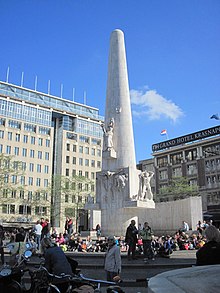National Monument (Amsterdam)
| Nationaal Monument | |

1 October 2010
|
|
| Coordinates | 52°22′22″N 4°53′37″E / 52.37278°N 4.89361°E |
|---|---|
| Location | Dam Square, Amsterdam, Netherlands |
| Designer | J.J.P. Oud |
| Material | white travertine stone |
| Height | 22 metres (72 ft) |
| Beginning date | 1952 |
| Opening date | 4 May 1956 |
| Dedicated to | World War II memorial |
The National Monument on Dam Square (Dutch: Nationaal Monument or Nationaal Monument op de Dam), Amsterdam, is a 1956 World War II monument in the Netherlands. A national Remembrance of the Dead ceremony is held at the monument every year on 4 May to commemorate the casualties of World War II and subsequent armed conflicts.
The monument was designed by Dutch architect J.J.P. Oud, and the monument's sculptures are by John Rädecker and his sons Han and Jan Willem Rädecker. The reliefs are by the sculptor Paul Grégoire.
The central element of the monument is a concrete conical pillar 22 metres (72 ft) in height, covered entirely by white travertine stone. On the front of the pillar is a relief entitled De Vrede ("Peace"), consisting of four chained male figures, representing the suffering endured during the war. To either side of these central figures are two male sculptures representing members of the Dutch resistance, the left figure symbolizing the resistance by the intelligentsia and the right figure symbolizing the resistance by the working classes. Weeping dogs are at their feet, representing suffering and loyalty. Above the central relief is a sculpture of a woman with a child in her arms and doves flying around her, representing victory, peace, and new life. A relief of the back side of the pillar shows doves ascending into the sky, symbolizing the liberation.
The monument is placed on a series of concentric rings, forming steps up to the monument. In front of the monument, on either side, are two sculptures of lions on circular pedestals, symbolizing the Netherlands. A semicircular wall surrounds the back side of the monument. The wall contains eleven urns with soil from World War II execution grounds and war cemeteries in each of the Dutch provinces. Three years later, a twelfth urn was added with soil from the Dutch East Indies, present-day Indonesia.
The pillar carries an inscription in Latin:
Hic ubi cor patriae monumentum cordibus intus
quod gestant cives spectet ad astra dei.
...
Wikipedia
